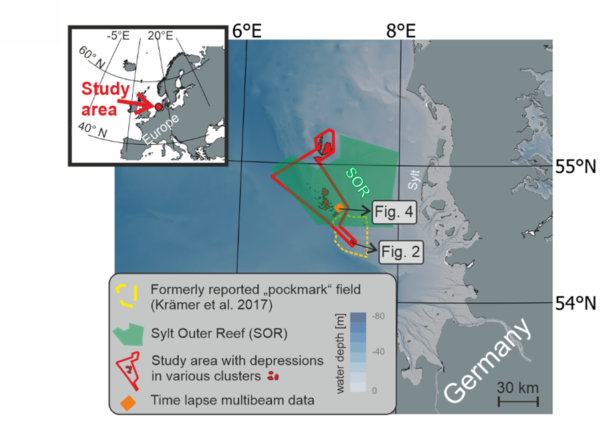Scientists from Kiel University have examined crater-like depressions on the seafloor of the North Sea. They were able to show that these directly relate to the habitats of porpoises and sand eels, and for the first time provide a conclusive explanation for the importance of vertebrates in shaping the seafloor.
The North Sea seafloor is dotted with thousands of crater-like depressions in the sediment known as pockmarks. They are formed by fluid discharge such as the greenhouse gas methane or groundwater, according to common scientific understanding.
“Our results show for the first time that these depressions occur in direct connection with the habitat and behaviour of porpoises and sand eels and are not formed by rising fluids”, says Dr Jens Schneider von Deimling, lead author of the current study and geoscientist at Kiel University.
“Our high-resolution data provide a new interpretation for the formation of tens of thousands of pits on the North Sea seafloor, and we predict that the underlying mechanisms occur globally, but have been overseen until now”, Schneider von Deimling adds.
Vertebrates leave pits in the seabed of the North Sea
Most of the depressions in the seafloor in the German Bight, the team suspects, are created by porpoises and other animals in search of food, and then scoured out by bottom currents. The sand eel, a small eel-like fish that spends most of the year buried in shallow sediments, plays a key role in this process.
“From analyses of the stomach contents of stranded porpoises, we know that sand eels are an important food source for the North Sea population”, says Dr Anita Gilles of the TiHo-Institute for Terrestrial and Aquatic Wildlife Research (ITAW), who has long studied the biology of marine mammals. In their study, the researchers showed that the marine mammals leave pits in the seafloor when they hunt for buried sand eels. Although these pits resemble the familiar pockmarks, they are much shallower.
Advanced multibeam echosounder technology provides information on pit condition
The detection of the pits has only become possible in recent years with the help of modern multibeam echosounder technology, which is taught and practiced intensively at Kiel University. In the North Sea, the researchers identified 42458 of these enigmatically shaped, shallow pits with an average depth of just eleven centimetres, which differ in their morphology from the more conical craters of the pockmarks.
An interdisciplinary approach leads to the harbour porpoise pits hypothesis
The key to the new findings was an interdisciplinary approach that brought together geological studies, geophysical sonar measurements, vertebrate behaviour and feeding biology, satellite evaluation, and oceanographic analysis. By precisely analysing millions of echo soundings collected by German research vessels, the researchers were able to locate the unusual pits. “Using special echo sounding methods, we can now measure the seafloor with centimetre precision and thus find the shallow pits. We can also look into the seafloor and see, for example, whether there is free methane gas”, explains AWI researcher Dr Jasper Hoffmann.
From the North Sea into the world: results with far-reaching effects
The research team currently believes that the initial feeding pits serve as a nucleus for scouring and eventually develop into larger pits. This finding also has global implications. The scouring of sediments by vertebrates in the ocean could modulate the seafloor on a global scale and influence benthic ecosystems. In the study area alone, pits cover nine percent of the seafloor.
Initial volume estimates indicate that 773369 tons of sediment have been deposited over an area of 1581 km². This is roughly equivalent to the weight of half a million cars. “Our results have far-reaching implications from a geological and biological perspective. They can help to assess the ecological risks associated with the expansion of renewable energies in the offshore sector and thus improve marine environmental protection”, concludes Schneider von Deimling.
The full journal article in Communications Earth & Environment can be read here.
